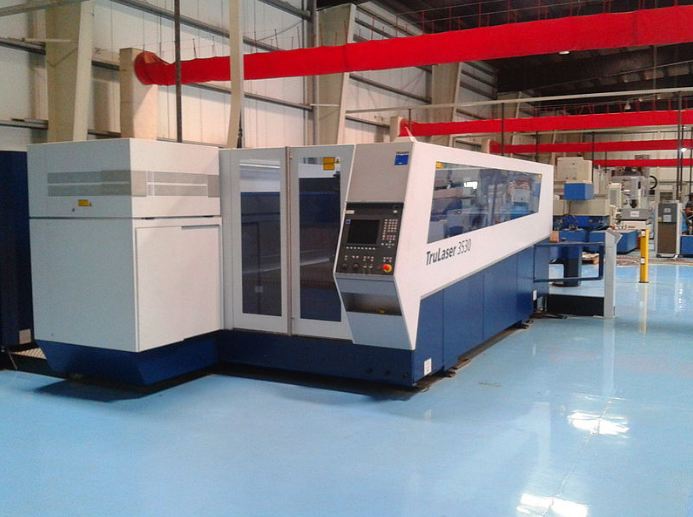Laser cutters are powerful manufacturing tools that are mostly used in fabrication industries. However, the advancement of technology has allowed such machines to make their way inside homes as well. While these machines complete jobs that used to take weeks back in the day, they also have a dark side especially related to health concerns.
Just as factories with laser cutters follow a set of rules and precautions, the same goes for home laser cutters. So, let’s discuss how laser cutting can be potentially harmful to your health.
Laser Cutting Health Hazards
Fire
When it comes to laser cutting, there are a lot of materials that can catch fire including wood. Before using a laser-cutting machine, it is advised that a safety plan is implemented and followed. This way, you can prevent ruining your machine as well as become aware of the materials that can catch fire during the process.
Furthermore, materials such as polypropylene, polystyrene, HDPE, and ABS tend to catch fire instead of being cleanly cut. Therefore, having proper knowledge of what can be disastrous and harmful is necessary before things turn for the worst.
Beam Escape
Laser-cutting machines need to be covered and well-shielded to prevent the beam from escaping. The beam is extremely hot and cuts through anything in its way within seconds. As a result, a laser-cutting machine not securely covered can pose serious laser cutting health concerns.
In addition to injuring the user, the beam can also injure bystanders or anything in its surrounding. Most hobby-grade laser-cutting machines have features that protect the beam from escaping. Unfortunately, some cheap options are also available in the market today that are not backed by adequate security features.
To ensure that your machine is safe and protected, you should inspect it regularly and lookout for any signs that might point towards a future problem.
Fumes
While laser beam escaping is one concern, the fumes are another. Most laser cutting health issues are a direct result of the byproduct, which in this case are fumes. Back in the day, when industrial laser-cutting machines were introduced, there were no regulations or laws controlling the effect of the fumes.
According to several studies, fumes can pose serious laser cutting health issues amongst children and workers when inhaled and regularly exposed to. At the same time, the fumes produced also depend on the materials you choose to cut. All materials produce fumes when cut. This is why it is important that both the machine and the room be properly ventilated.
There are no hard and fast rules on how much ventilation is sufficient. It depends on the type and usage of the laser-cutting machine. Upon cutting materials, the release of volatile organic compounds is a must. If you are cutting paper products and hardwoods, the amount of VOCs released is equal to a wood-burning stove or sitting around a campfire.
As a result, prolonged exposure can lead to asthma and respiratory problems. Furthermore, complex materials like plastics and plywoods can create nasty compounds, which again makes it important for you to know what is going into your laser-cutting machine.
Materials You Should Not Cut Using a Home Laser Cutter
PVC
Polyvinyl Chloride or PVC is the first to raise laser cutting health effects. Almost everyone is aware of chloride and its harmful effects. So, you should already have an idea of how PVC can impact your health if it is engraved or cut. Cutting or engraving PVC releases ethylene dichloride, dioxin, and hydrogen chloride, etc.
These compounds are most likely to destroy your machine and cause severe chronic and acute exposure problems including cancer and damage to the reproductive and immune system. PVC is particularly concerning considering it is available in almost every household nowadays.
Polycarbonate
Polycarbonate is made using phosgene, which is something you wouldn’t want yourself and your family members to be exposed to. It cannot be said exactly to what extent cutting polycarbonate remobilizes phosgene but polycarbonate is proven to be harmful to laser-cutting machines. Therefore, you need to be careful.
How to Be Safe When Laser Cutting at Home?
Keep It Isolated
As mentioned earlier, the beam of a laser-cutting machine can easily escape if not well-shielded. This means that you should place it in an isolated room and lock it so that the kids in your house cannot access it.
Additionally, if your children are old enough, you should warn them of the consequences. Teach them all the safety procedures and share what you intend to do with the machine.
Signage
If the machine is placed out in the open for some reason, you should display warning signs. Manufacturing and fabrication industries are required by law to install signs to prevent mishaps and accidents. The reason is that some people are curious without knowing how dangerous a machine might be.
Final Word
Laser cutters are dangerous and potentially harmful machines. The best way to ensure that your health is not at risk each time is by knowing what materials and ways can bring you harm. You should always wear safety equipment even if the task at hand is minor. Plus, if the machine is coming home, make sure that you consider ventilation before installation.
